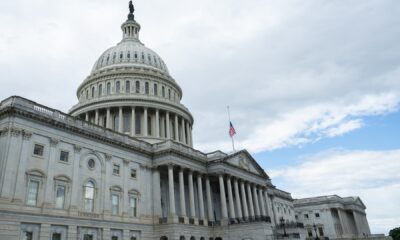Senate Majority Leader John Thune (R-South Dakota), from left, Sen. John Barrasso (R-Wyoming) and Senator Mike Crapo (R-Idaho) exit the West Wing of the White House on June 4, 2025. The Senate has begun deliberations over President Donald Trump’s massive “Big Beautiful Bill” that narrowly passed the House on May 22, with several Republican senators expressing concerns over its cost as well as cuts to Medicaid and clean energy tax credits.
Photographer: Eric Lee/Bloomberg via Getty Images
Republicans on Capitol Hill are weighing legislation that’s estimated to cut billions of dollars of funding for the Affordable Care Act and cause millions of people to lose their health insurance. Many of their constituents may not be happy about it, polling suggests.
Nearly half, 45%, of adults enrolled in a health plan offered through the ACA insurance marketplace identify as Republicans, according to a new survey by KFF, a nonpartisan group that conducts health policy research.
(More than three-quarters of those Republican ACA users identify as “MAGA” Republicans. Those MAGA Republicans represent 31% of ACA purchasers overall.)
Meanwhile, 35% of Democrats get their health insurance through the ACA, KFF found.
Republicans in the House of Representatives passed a multitrillion-dollar tax and spending package in May estimated to cut about $900 billion from health programs like Medicaid and the ACA, which is also known as Obamacare.
Senate Republicans are now considering the measure, which contains many of President Donald Trump’s domestic policy priorities. Republicans are trying to pass the megabill by the Fourth of July.
If the GOP enacts the legislation as written and doesn’t extend tax credits that lower monthly ACA health premiums, about 15 million people would lose health insurance, according to the Congressional Budget Office.
“A large constituency of Republicans using the programs are potentially facing cuts,” said Audrey Kearney, a senior survey analyst for KFF’s public opinion and survey research program.
The survey was conducted May 5 to 26 among a nationally representative sample of 2,539 U.S. adults, including 247 who have purchased their own health coverage.
The Affordable Care Act also expanded Medicaid coverage to more households.
However, 10 states haven’t adopted the expansion: Alabama, Florida, Georgia, Kansas, Mississippi, South Carolina, Tennessee, Texas, Wisconsin and Wyoming. All voted for Trump in the 2024 presidential election.
Republicans are “more likely to live in nonexpansion states,” John Graves, a professor of health policy and medicine at Vanderbilt University School of Medicine, wrote in an e-mail.
More from Personal Finance:
Job market is ‘trash’ right now
What ‘revenge tax’ in Trump spending bill may mean for investors
When it comes to saving, Gen Z asks: ‘What’s the point?’
Here’s why this matters for ACA enrollment: “In the non-expansion states, there’s a wider population eligible for the tax credits,” said Carolyn McClanahan, a physician and certified financial planner based in Jacksonville, Florida. She’s a member of the CNBC Financial Advisor Council.
In states that expanded Medicaid, nearly all adults with incomes up to 138% of the federal poverty line (about $22,000 for a one-person household in 2025) are eligible for Medicaid.
In states that didn’t expand Medicaid, a broader population is eligible for subsidies to make ACA health plans less expensive, Graves said. The subsidized exchanges are available for people between 100% and 138% of the federal poverty line, among others.
“Given the heavy subsidies in that income range, and large amount of otherwise uninsured people, that would suggest more GOP-identifying people with low incomes would go the (subsidized) exchange route,” Graves wrote.
The Affordable Care Act has been vilified by Republicans since passage during President Barack Obama’s tenure. However, provisions within the law — such as creation of the ACA marketplaces, coverage for those with pre-existing conditions and the ability to stay on parents’ health plan until age 26 — have broad appeal, said KFF’s Kearney.
As of 2023, nearly 1 in 7 U.S. residents had enrolled in an ACA marketplace plan at some point since 2014, the year in which states rolled out marketplace plans, according to a 2024 report from the U.S. Department of the Treasury.
“Our polling going back years has shown that when you ask about favorability of the ACA itself, Republicans view it as pretty unfavorable,” she said. “However, the actual provisions in it are very popular, and are popular among Republicans.”


 Blog Post1 week ago
Blog Post1 week ago
 Personal Finance1 week ago
Personal Finance1 week ago
 Economics1 week ago
Economics1 week ago
 Economics1 week ago
Economics1 week ago
 Economics4 days ago
Economics4 days ago
 Finance4 days ago
Finance4 days ago
 Economics4 days ago
Economics4 days ago
 Economics4 days ago
Economics4 days ago











